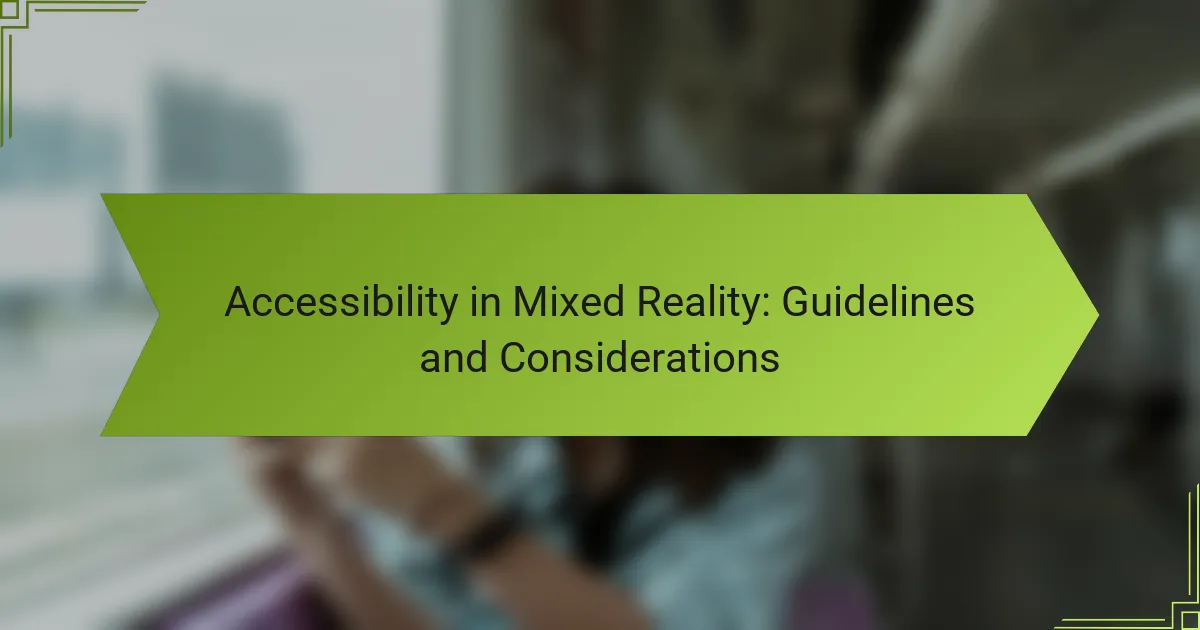Accessibility in mixed reality is essential for creating inclusive experiences that cater to users with diverse needs. By implementing features such as audio descriptions, haptic feedback, and customizable interfaces, developers can enhance usability and ensure effective engagement with the technology. Adhering to established guidelines and involving users with disabilities in the design process not only meets legal standards but also improves the overall user experience.

What are the best practices for accessibility in mixed reality?
Best practices for accessibility in mixed reality focus on creating inclusive experiences for users with diverse needs. This includes implementing features that enhance usability, such as audio descriptions, haptic feedback, and customizable interfaces, ensuring that all users can engage effectively with the technology.
Incorporating audio descriptions
Audio descriptions provide verbal narration of visual elements, making mixed reality experiences accessible to users with visual impairments. This practice involves describing key actions, settings, and visual cues in real-time, allowing users to understand the context without relying solely on sight.
To implement audio descriptions effectively, consider using clear and concise language. Test the descriptions with users who have visual impairments to ensure they enhance the experience rather than distract from it.
Utilizing haptic feedback
Haptic feedback uses vibrations or motions to convey information, providing a tactile dimension to mixed reality. This feature can alert users to important events, guide them through interactions, or enhance immersion by simulating physical sensations.
When designing haptic feedback, ensure that the intensity and duration are adjustable to accommodate different preferences and sensitivities. Offering a variety of feedback patterns can help users distinguish between different types of interactions.
Ensuring visual contrast
Visual contrast is crucial for users with visual impairments or color blindness. High contrast between text and background elements improves readability and helps users navigate mixed reality environments more easily.
Use color contrast checkers to ensure compliance with accessibility standards, aiming for a contrast ratio of at least 4.5:1 for normal text. Providing options for users to adjust color schemes can further enhance accessibility.
Implementing customizable user interfaces
Customizable user interfaces allow users to tailor their experience according to their individual needs and preferences. This can include resizing text, changing color schemes, or rearranging interface elements for easier access.
Encourage user feedback during the design process to identify common preferences and potential barriers. Providing a simple, intuitive way for users to make these adjustments can significantly improve overall accessibility in mixed reality applications.
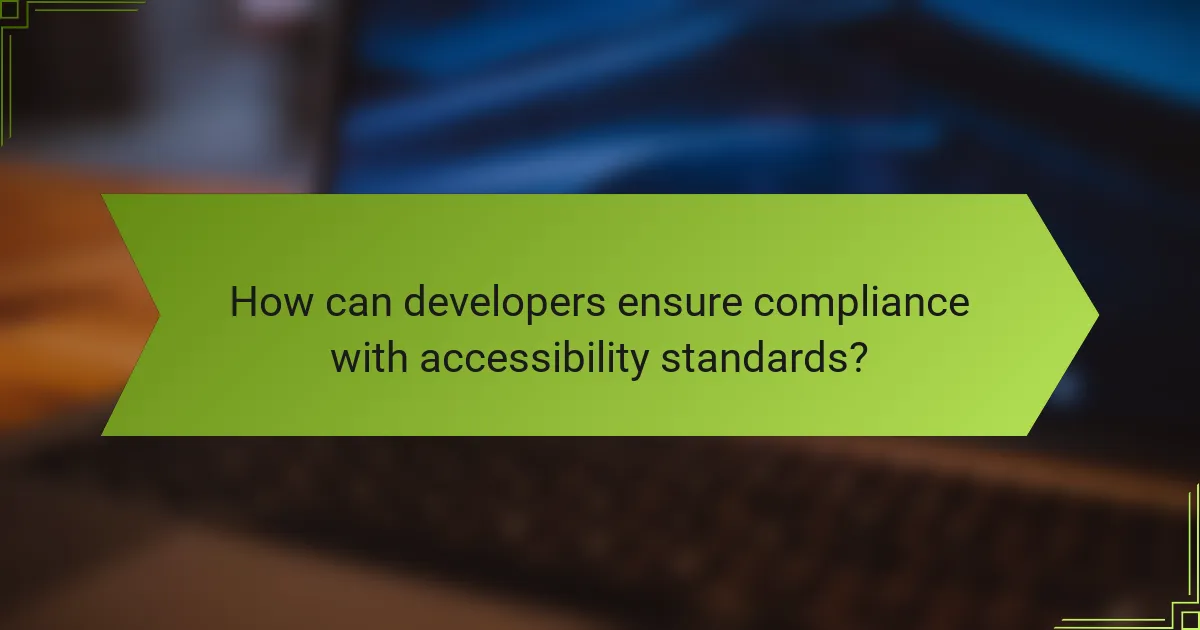
How can developers ensure compliance with accessibility standards?
Developers can ensure compliance with accessibility standards by following established guidelines and actively involving users with diverse needs in the design process. This approach not only meets legal requirements but also enhances the user experience for everyone.
Following WCAG 2.1 guidelines
Adhering to the Web Content Accessibility Guidelines (WCAG) 2.1 is crucial for developers aiming to create accessible mixed reality experiences. These guidelines provide a comprehensive framework covering various aspects of accessibility, including text readability, color contrast, and navigational ease.
Key principles of WCAG 2.1 include perceivable, operable, understandable, and robust content. For instance, ensuring that all interactive elements are keyboard-navigable and providing text alternatives for non-text content are essential steps. Regularly reviewing compliance against these standards can help identify areas for improvement.
Conducting user testing with diverse groups
User testing with diverse groups is vital for identifying accessibility issues that may not be apparent to developers. Engaging individuals with various disabilities, including visual, auditory, and motor impairments, allows for a more comprehensive understanding of user needs and challenges.
Consider organizing testing sessions that include participants from different backgrounds and abilities. Collect qualitative feedback on their experiences and observe how they interact with the mixed reality environment. This feedback can guide iterative design improvements, ensuring that the final product is inclusive and user-friendly.
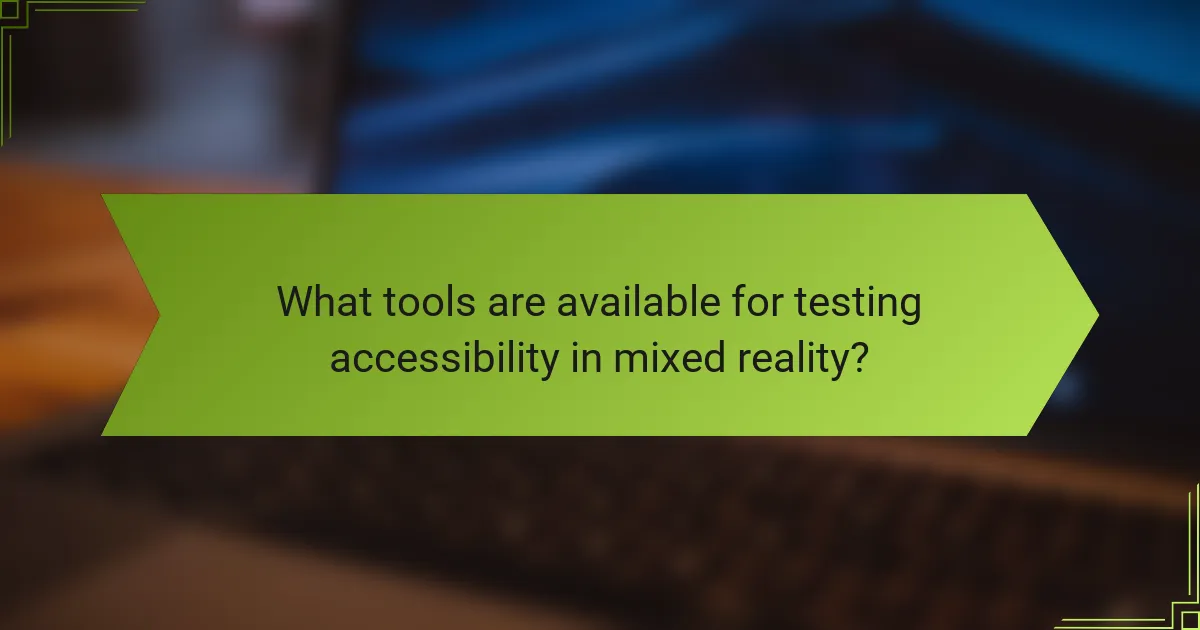
What tools are available for testing accessibility in mixed reality?
Several tools are designed to evaluate accessibility in mixed reality environments, helping developers ensure their applications are usable for individuals with disabilities. These tools provide insights into potential barriers and offer recommendations for improvement.
Microsoft Accessibility Insights
Microsoft Accessibility Insights is a powerful tool that assists developers in identifying accessibility issues in their mixed reality applications. It offers automated checks and guided manual assessments, enabling users to evaluate compliance with accessibility standards like WCAG.
This tool is particularly useful for developers working on Windows Mixed Reality applications, as it integrates seamlessly with Visual Studio. It provides actionable insights and suggestions for fixing identified issues, making it easier to create inclusive experiences.
Google Accessibility Scanner
The Google Accessibility Scanner is a mobile tool that analyzes Android applications for accessibility problems. While primarily aimed at traditional apps, it can also be applied to mixed reality experiences developed for Android devices.
This scanner highlights areas needing attention, such as text contrast and touch target sizes, and offers recommendations for improvement. Developers can use these insights to enhance usability for users with disabilities, ensuring a more accessible mixed reality experience.
Unity Accessibility Toolkit
The Unity Accessibility Toolkit is designed specifically for developers using the Unity engine to create mixed reality applications. It provides a set of tools and best practices to help integrate accessibility features directly into the development process.
Key components include guidelines for implementing voice commands, haptic feedback, and visual adjustments. By following these recommendations, developers can create more inclusive applications that cater to a wider audience, including those with various disabilities.
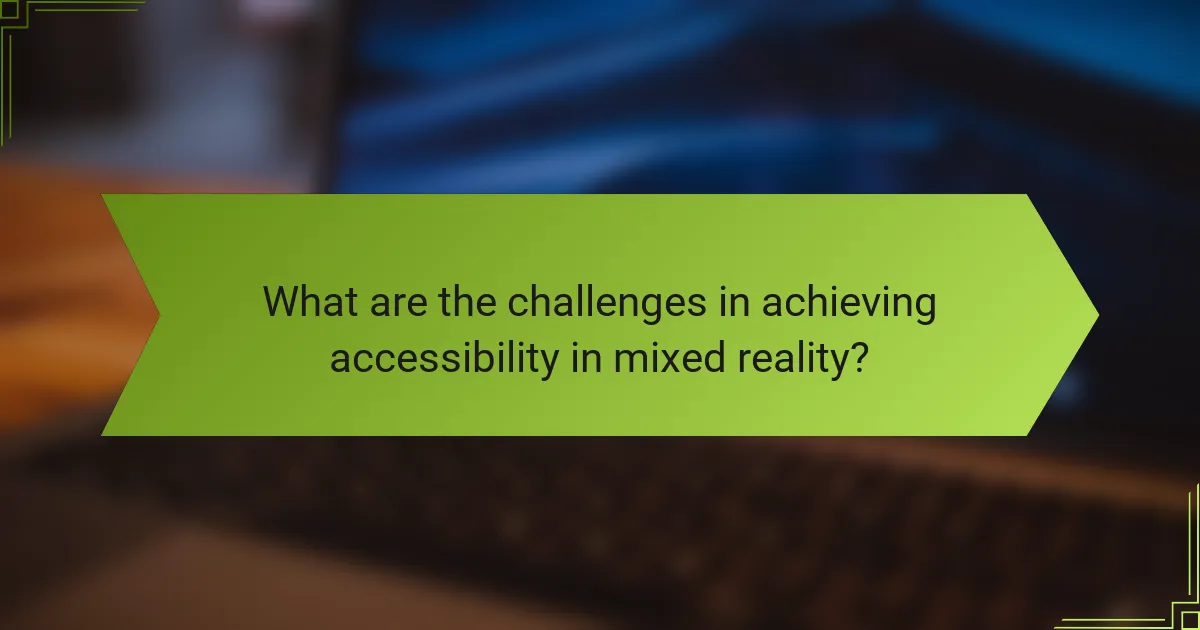
What are the challenges in achieving accessibility in mixed reality?
Achieving accessibility in mixed reality (MR) presents several challenges, primarily due to the diverse needs of users and the evolving technology. Key obstacles include technical limitations of hardware, a lack of standardized guidelines, and the complexity of user interactions.
Technical limitations of hardware
Mixed reality hardware often has constraints that hinder accessibility, such as limited processing power, inadequate display resolutions, and insufficient input methods. For instance, devices may not support adaptive technologies like screen readers or alternative input devices, making it difficult for users with disabilities to engage fully.
When selecting MR hardware, consider devices that offer customizable settings and compatibility with assistive technologies. Look for features like adjustable display settings and voice command capabilities to enhance user experience.
Lack of standardized guidelines
The absence of universally accepted accessibility guidelines for mixed reality creates inconsistencies in user experiences. While some organizations advocate for best practices, there is no single framework that developers must follow, leading to varied implementations across applications.
To address this, developers should refer to existing accessibility standards, such as the Web Content Accessibility Guidelines (WCAG), and adapt them to the MR context. Engaging with users during the design process can also help identify specific accessibility needs.
Complexity of user interactions
Mixed reality environments often involve intricate user interactions that can be overwhelming for individuals with cognitive or physical disabilities. The need to navigate virtual spaces, manipulate 3D objects, and interact with multiple interfaces can create barriers to effective use.
To simplify interactions, developers should prioritize intuitive design and provide clear instructions. Implementing user-friendly navigation aids, such as voice commands or gesture controls, can significantly enhance accessibility for a broader range of users.

How can mixed reality experiences be tailored for specific audiences?
Mixed reality experiences can be customized to meet the diverse needs of specific audiences by incorporating accessibility features that address various disabilities. Understanding the unique requirements of each group ensures that all users can engage with the content effectively and enjoyably.
Designing for users with visual impairments
When designing for users with visual impairments, consider incorporating high-contrast colors and adjustable text sizes to enhance readability. Use audio descriptions to convey visual information and ensure that navigation elements are easily identifiable through tactile or auditory feedback.
Implementing features like screen readers and voice commands can significantly improve accessibility. Testing with users who have visual impairments can provide valuable insights into usability and help identify areas for improvement.
Adapting experiences for users with hearing loss
To adapt mixed reality experiences for users with hearing loss, provide visual cues and captions for all audio content. This includes transcribing spoken dialogue and using visual indicators to signal important sounds or alerts within the environment.
Consider integrating sign language interpretation for critical interactions. Additionally, ensure that users can adjust audio settings to suit their preferences, such as increasing volume for specific sounds while reducing background noise.
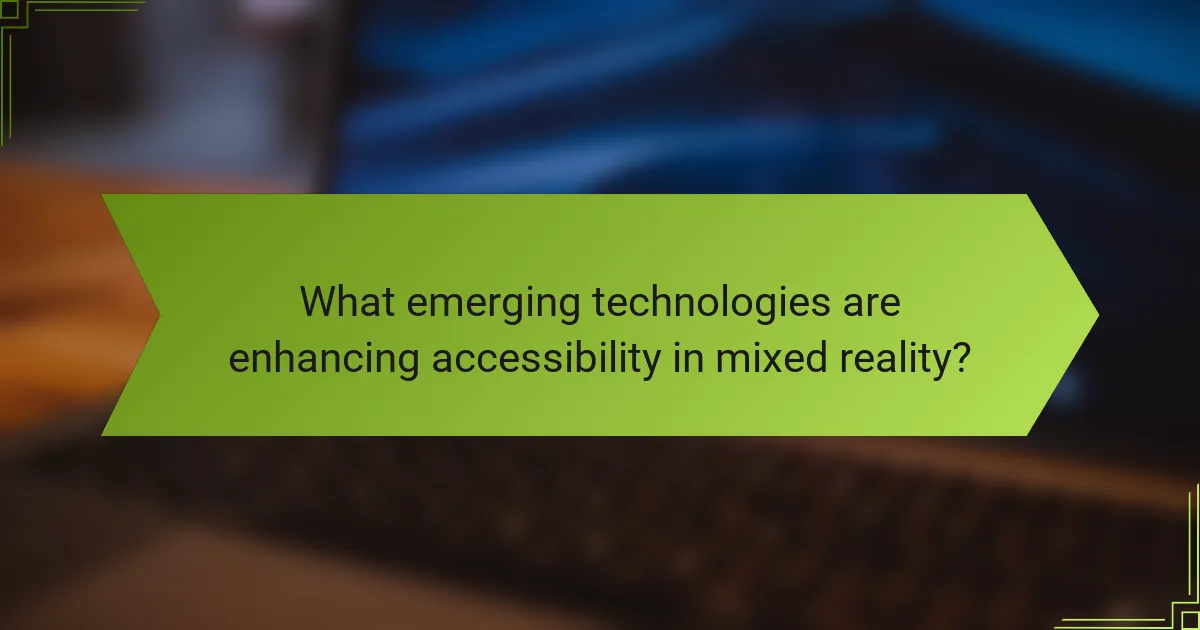
What emerging technologies are enhancing accessibility in mixed reality?
Emerging technologies are significantly improving accessibility in mixed reality (MR) by integrating features that cater to diverse user needs. These advancements focus on making MR environments more navigable and usable for individuals with disabilities, enhancing their overall experience.
AI-driven accessibility features
AI-driven accessibility features leverage machine learning to adapt MR experiences to individual user requirements. For instance, AI can analyze user behavior and preferences, adjusting visual and auditory elements in real-time to enhance comprehension and interaction.
Examples include voice recognition systems that allow users to navigate MR environments through spoken commands, and text-to-speech applications that convert on-screen text into audible content. These tools can significantly reduce barriers for users with visual or mobility impairments.
Advancements in gesture recognition
Advancements in gesture recognition technology are transforming how users interact with mixed reality. This technology allows users to control MR applications through natural hand movements, eliminating the need for physical controllers that may be difficult for some individuals to use.
For example, systems that utilize depth sensors can accurately interpret a wide range of gestures, enabling users to perform actions like selecting objects or navigating menus with simple hand motions. This can greatly enhance the experience for users with limited dexterity or those who prefer touchless interaction.
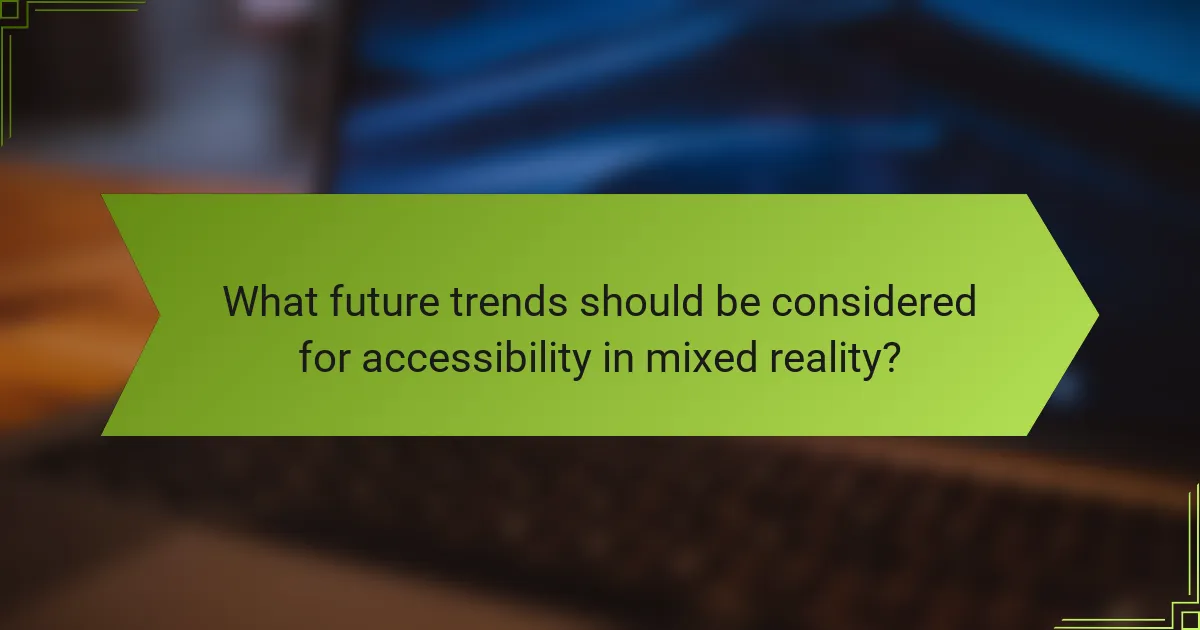
What future trends should be considered for accessibility in mixed reality?
Future trends in accessibility for mixed reality (MR) focus on enhancing user experience for individuals with disabilities. Key considerations include adaptive technologies, inclusive design practices, and compliance with emerging accessibility standards.
Adaptive technologies in mixed reality
Adaptive technologies play a crucial role in making mixed reality environments more accessible. These technologies can include voice recognition systems, gesture controls, and haptic feedback devices that cater to users with varying abilities. For instance, a user with limited mobility might benefit from voice commands to navigate virtual spaces.
As MR continues to evolve, integrating adaptive technologies will require collaboration between developers and accessibility experts. This ensures that the tools are effective and meet the needs of diverse users. Regular user testing with individuals who have disabilities can provide valuable insights into necessary adaptations.
Inclusive design practices
Inclusive design practices are essential for creating mixed reality experiences that accommodate all users. This approach emphasizes designing for a wide range of abilities from the outset, rather than retrofitting solutions later. For example, incorporating adjustable text sizes and color contrasts can significantly enhance readability for users with visual impairments.
To implement inclusive design, teams should engage in user-centered design processes, involving people with disabilities in the development stages. This collaboration can lead to innovative solutions that improve accessibility and overall user satisfaction.
Compliance with accessibility standards
Compliance with established accessibility standards is vital for ensuring that mixed reality applications are usable by everyone. Guidelines such as the Web Content Accessibility Guidelines (WCAG) and the Americans with Disabilities Act (ADA) provide frameworks for developers to follow. Adhering to these standards can help avoid legal issues and enhance market reach.
Regular audits and updates to MR applications are necessary to maintain compliance as standards evolve. Developers should stay informed about changes in regulations and best practices to ensure ongoing accessibility for all users.
